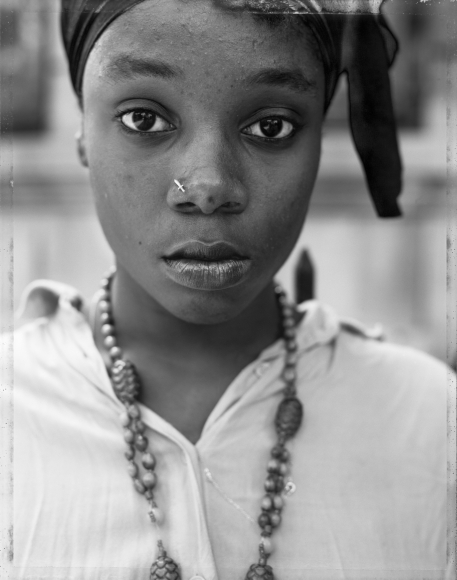__________________________________
Dawoud Bey : A Girl With a Knife Nosepin from Street Portraits
While Dawoud Bey’s first exhibition of street portraits entitled Harlem USA (1975 – 1979) showed at Studio Museum in Harlem in 1979, this image is from “Street Portraits”, a series he began in the late 1980’s and early 1990’s.
______________________________________
A Girl with a Knife Nosepin is summarily dazzling, insightful & relevant!
The portrait exposes a young girl ordinarily self-possessed and in command of her environment: vigorous and confident on the street in her neighbourhood. Yet a transient defiant wariness pegs her direct yet closed expression. Conceivably emboldened by Bey, she finds herself an active protagonist in an unusual situation – not fully understanding or trusting the outcome: her striking gaze confirms Bey’s comment:
…to make it feel like the “most natural thing” even though it clearly isn’t.
___________________________________

Engaged ‘in this way for the first time’, she synchronically imparts a mix of commitment, uncertainty and tenacity. The momentary tentativeness is conveyed by the sheen on her lips and the reality of shadowing the left side of her face. These attributes are enhanced by the end of her scarf, which draws attention to the shadow and the fact that like most human faces, this face is asymmetrical. The sharp close-up, scarf excess, and partial shadowing appear to gently weigh down the left side of her face.
Additionally, the scarf can be read as an idiosyncratic character indicator – as is the knife nosepin, but where the scarf foregrounds the dire roots of black African American history (and identification with that history), the knife nosepin displays contemporary life and attitudes. Interestingly, occupying opposite sides of the face: this passing coincidence indicates that any one individual is the sum of past and present, as well as the sum of the mirrors reflecting back the life they see themselves in.
Moreover, the above devices propound the feeling that this young girl has encountered a share of life’s aberrations – the dark circle around her left eye amplifies her vulnerability – teen life is ordinarily a continuum of vicissitudes – everything about this girl suggests the changing face of youth and identity. The imperfectly perfect face of youth.
The large format negative holds a lot more material information than a small 35mm negative. One can make larger prints from these negatives without the image breaking up into grain and losing its highly descriptive and material quality. This idea of “being able to make large prints of African Americans, and give them an enhanced physical presence through my work” ,was very appealing also.
The scarf is live with implications, reflecting the individual as a mix of social oppositions – at once, typical, political, and unique. Conceivably, the headscarf functions as a visual metaphor for slavery, an apparently innocent article of clothing referencing the history of black African Americans.
…history is the thing I am mostly preoccupied with in my work
Whilst assuming information from an image that is not there can be a trap, it is difficult to ignore the symbolism of black and white, and the attendant symbolism of moving from a state of darkness into the light when viewing A Girl With Knife Nosepin. The division between the left side of her face and the right is impossible to ignore once recognised. Just as the exhibition Harlem on My Mind in 1969 was the catalyst for Bey’s career – one that has spanned over forty years, the history of black African Americans is dogged by the darkness of deeply entrenched racism evolving from centuries of slavery in the south. Emerging from that darkness is a long road of enquiry, together with the impossibly slow journey towards enlightenment of the masses – the death of George Floyd and consequently, the Black Lives Matter movement are indicative.
This young girl is the symbol of black American pride and history: she owns that history to interpret exclusively as a personal virtue. Bey and his subject(s) are collaborating in exceptional contemporaneous circumstances, presenting a ‘snapshot’ of time from which the past is both inescapable and motivating.
From 1988 to 1991 Dawoud Bey made a series of portraits of African Americans in the streets of various American cities….he asked a cross section of the populations of these communities to pose for him, creating a space of self presentation and performance in the streets of the urban environment.
Adolescence presupposes greater challenges in adult life. Right now, the direct relationship with the camera alludes to integral yet suspended possibility, a sense of authority, and some cynicism. Nevertheless, her powerful gaze and the knife nose pin suggest a strong identity in control of her own destiny. The sum of this young girl’s life can be interpreted allegorically as maturity and innocence, or wisdom and naivety. Experienced beyond her years, she is poised, experimental and willing to take on the world.
The essence and success of the series are one and the same thing. While not spontaneous in the strict sense, Bey’s choice of subject and technique identify a young woman apprehended as a contradiction, possessing both prevailing depth of character and a fleeting passing expression. Added to this are the more abiding qualities of legitimacy, complexity and individuality.
_________________________________________________
Dawoud Bey is represented by:
Stephen Daiter Gallery Chicago
Rena Branston Gallery San Francisco
Sean Kelly Gallery New York


























